A first-time visitor to France is NOT likely to choose Vezelay as his/her prime destination. Indeed, why to bother and go to a small (population 400) provincial town, which is far from major tourist destinations (125 km / 80 miles to Dijon, 250 km / 170 miles to Paris) and relatively hard to reach because there is no railway station there (the nearest in Sermizelles is about 10 km / 7 miles away). No wonder, situated in North-Central France, in Bourgogne-Franche-Comte region, Vezelay remains “under the radar” for most tourists.
Even a more “advanced traveler” will probably simply say that Vezelay is a nice hill town with well preserved medieval walls and which is primarily known for Vézelay Abbey (also called Basilica of St. Mary Magdalene), a former 11th century Benedictine monastery. Because of great architectural value, both the town itself and the Abbey are designated as UNESCO World Heritage Sites.


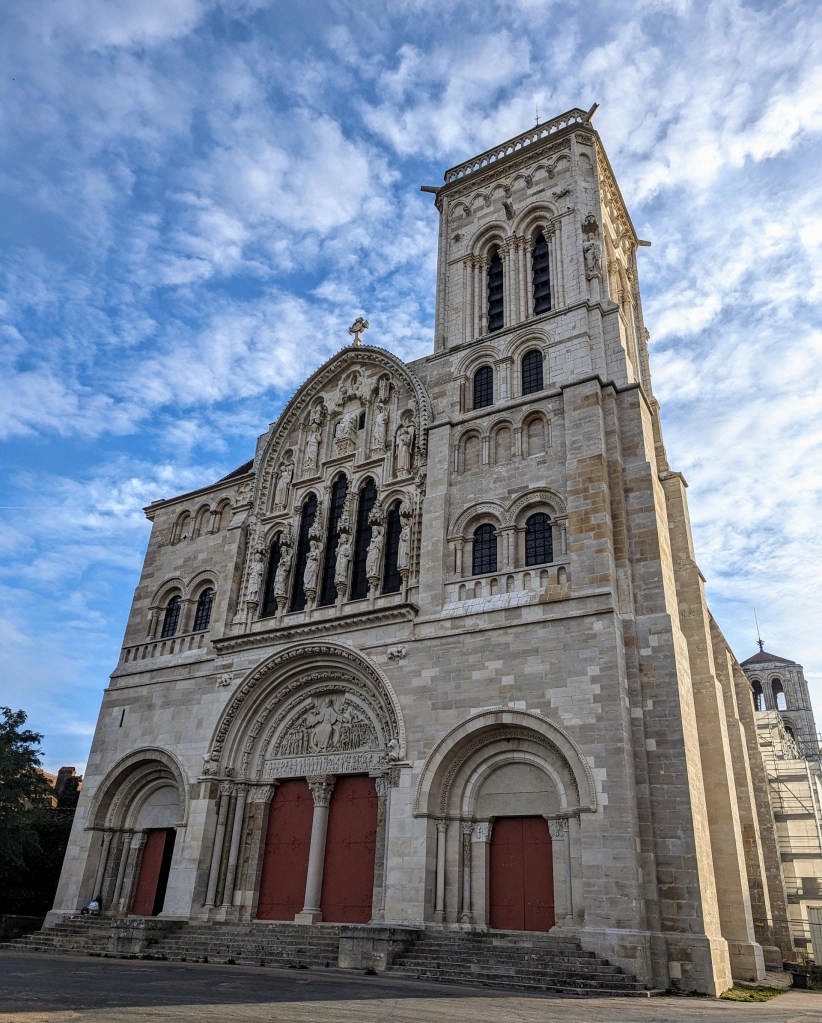
The Basilica of St. Mary Magdalene, the main Abbey’s church, is considered a fine masterpiece of Burgundian Romanesque art, because of its elaborate exterior and interior decorations.

What most people do not know is that Vezelay was a major religious and spiritual center in medieval Europe. In the 9th century a monk named Baudillon (Badilo) brought from the Holy Land the relics of Mary Magdalene to Vezelay (which was already owned by the Catholic order of Benedictines).
After Pope Stephen IX confirmed the authenticity of the relics (1058), Vezelay began to attract a huge influx of pilgrims and became a starting point for the pilgrimage on the Way of St. James to Santiago de Compostela. The town reached its peak of influence in the 12th century. In 1146, St Bernard preached in Vezelay the Second Crusade, and in 1190 the Frankish and English troops met here before departing to the Holy Land for the Third Crusade.
The decline of Vezelay began after the well-publicized discovery (1279) of the shrine with the body of Mary Magdalene at Saint-Maximin-la-Sainte-Baume in Southern France. This undermined Vézelay’s position as the principal pilgrimage destination for Mary Magdalene in Europe.
Its glorious past aside, today’s Vezelay managed to “blend” a vibrant spiritual life with more casual tourist experiences. The original “owners” of the town, the Benedictine monks, are long gone, but three other – very different – religious communities settled here: each attracting a flow of pilgrims, and simply curious visitors. I will tell more about all of them a bit later.
I came to Vezelay in late September by car, and the first sight of the town was not about “churches and religion” but rather “grapes and wines.”

As it turned out, there is a strong link between wine and religion in Vezelay. From the 1st century, the Romans planted vines here. The wine production in this area was so important that a Roman temple in honor of Bacchus was erected. In 1689, its remains were discovered by a local priest in the foundations of the old church of Saint-Etienne.
In 2017, Vezelay was awarded the status of “Village AOC.” In France, AOC (Apellation d’origine controlee) stands for a particular area where only certain types of wines and using only particular methods can be produced. Essentially, “AOC” label indicates high quality wines. With an area of only 260 hectares (640 acres), Vezelay is a very small AOC. Only wines made out of Chardonnay grapes can be labeled “Vezelay AOC.” Local vineyards also produce excellent red Pinot Noir wines, but they are labeled under more generic “AOC Bourgogne.”
I visited few vineyards, and my favorites were Domaine La Croix Montjoie (in a nearby village of Tharoiseau) and Domaine des Coeuriots (its has tasting room right on the main street of Vezelay). Both produce variety of good wines for a very reasonable price, both welcome visitors without any prior appointment, and both have welcoming and English speaking staff.


Enough about wine (although being in France this may be difficult). If you come to Vezelay by car, bear in mind that the non-residents cannot drive into town and have to park outside medieval walls. This is not a big deal: the town is small. Besides, the whole point is to discover Vezelay very slowly, literally “step-by-step.” After parking, you will first enter through this gate.

And then the main street called “Rue Saint Etienne” will take you into the heart of the town. Almost all what you need to see and experience in Vezelay is on this street. No French town is a “real town” without a local bakery (“boulangerie”). Vezelay has one, and it will be on your left side shortly after you enter town.

The reviews on Google maps on this bakery are not very favorable. However, everything what I tried there was excellent. My favorites were Chausson aux Pommes (small apple pies) and the local specialty called “Gougere” (a pastry baked out of dough mixed with cheese and with different fillings).


Vezelay is full of small galleries, artistic studios and antique shops for all “styles and tastes.” Simply walk Rue Saint Etienne and check out whatever appeals to you. Here you can see how these galleries look like.



Among these shops, two attracted my attention. One was a combination of a photo gallery/studio and photo exhibition on the history of everyday life in Vezelay.

In another gallery, I was greeted by a very cheerful lady. Her artistic work was an interesting blend of various materials: paint, paper, corroded metal, natural wood…
If galleries and artistic shops are not your “cup of tea,” then simply enjoy many examples of gorgeous and finely preserved homes. Like this one.

A very helpful thing about visiting Vezelay is that in many places you will find posted explanatory notes on the history, architecture and importance of various buildings. They are written both in French and English. Here is an example.
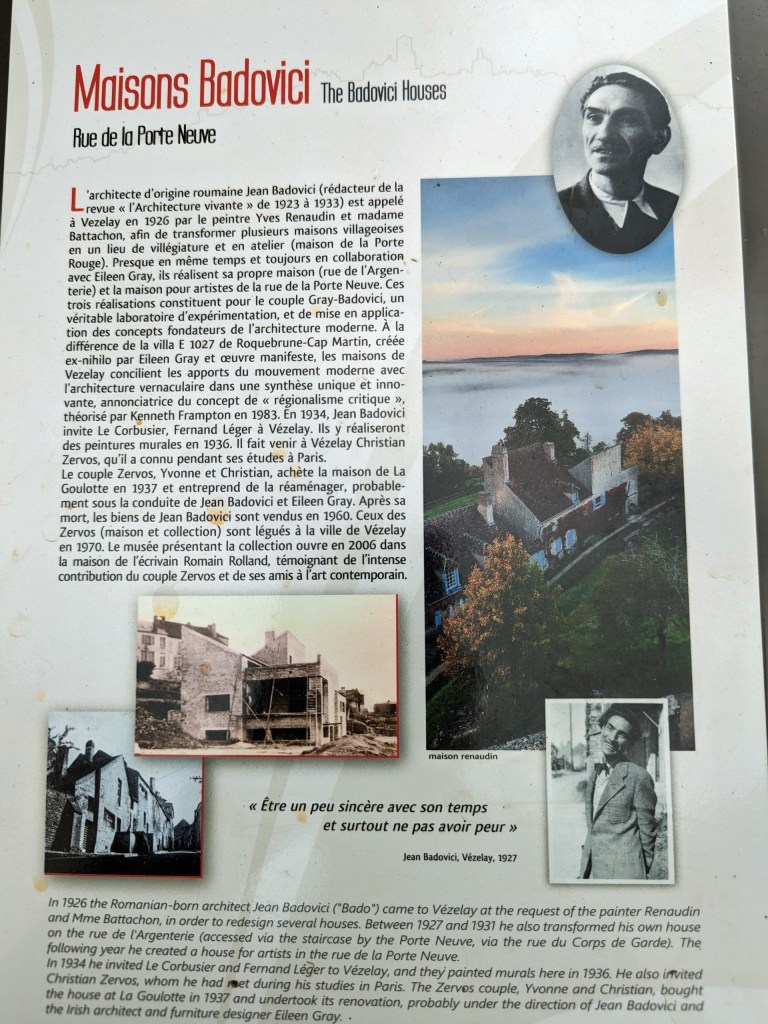
A “must” stop for everyone is “Hotel de Ville” (or “Mairie”): i.e. the City Hall. Set in an elegant mansion, one of its rooms features gorgeous 17th. century tapestries covering all walls of this room.


Shortly after City Hall, the main street (Rue Saint Etienne and then Rue Saint Pierre) will end up on a main plaza and in front of the Basilica of St. Mary Magdalene.

And now is time to begin the “spiritual journey” through the three religious communities which coexist peacefully in Vezelay: each with its own unique vibe and each attracting people from the different walks of life.
I noted already that Benedictine monks left Vezelay Abbey a long time ago, but, as a popular proverb suggests, “the holy place is never empty, and others come instead.” Since 1993 , Vezelay Abbey is occupied by the Catholic order Monastic Fraternities of Jerusalem. This order is relatively new: it was founded in 1975 by a French priest, Pierre Marie Delfieux.

The special mission of the Monastic Fraternities of Jerusalem is a rather unique, but, at the same time, very fitting into contemporary world.
Historically monastic movements emphasized life in seclusion and separation from the outside secular world so that a person can fully devote himself to the prayer and contemplative living. Instead, the aim of Monastic Fraternities of Jerusalem is to promote the spirit of the genuine monastic living (the idea of monastic desert) but being physically located in the heart of the modern cities.

Today, the Monastic Fraternities of Jerusalem have their communities in about dozen of locations in Europe and Canada. Vezelay Abbey is one of them. The mass (main Catholic worship service) is conducted every evening in the Basilica of St. Mary Magdalene. I attended and was taken aback by how solemn and, simultaneously, intimate the service was and how the sound of monastic choir filled the colossal volume of Basilica’s interior.

Predictably, the community of Fraternities of Jerusalem in Vezelay attracts many visitors. Some come just for a day, but some want to stay longer: to disconnect from everyday life, to spend time in prayer and meditation, and to talk with monks and nuns. For such people, the community offers simple but very comfortable accommodations. Called, Centre-Sainte-Madeline, it is located on the main street and literally just a few steps away from the Basilica. The old gates are typically open for everyone and invite to step inside.

Beyond these doors, one will find a spacious courtyard.
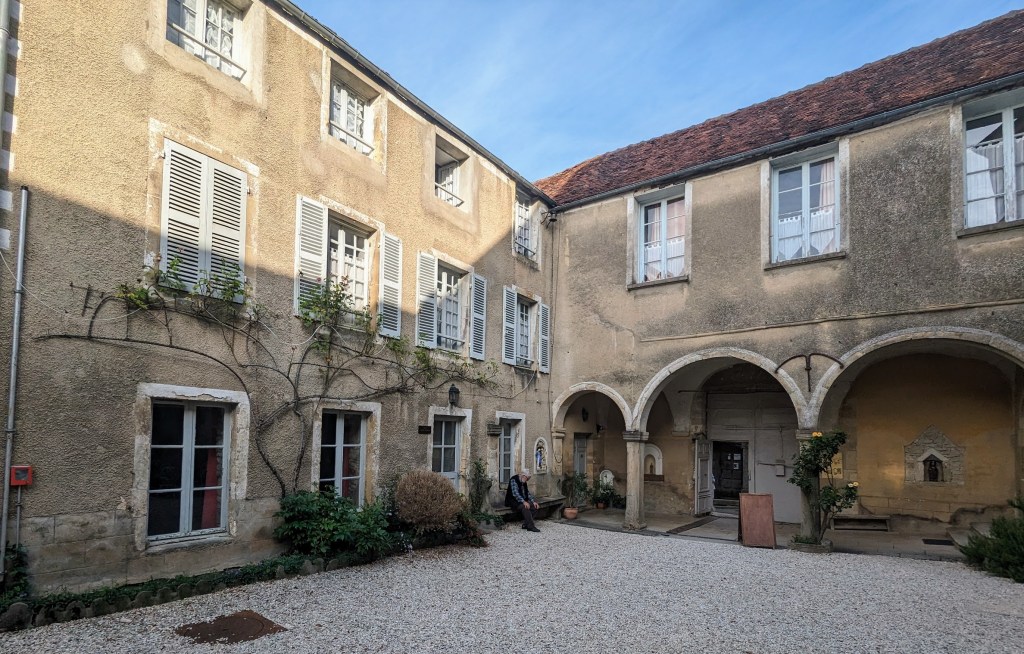
The accommodations range from the private to 4-beds dormitories. All rooms have sinks, while the showers and toilets are shared between several rooms.


The prices range from 18 to 30 Euro per night (20-35 USD): a hard to beat deal! If you decide to stay at the Centre-Sainte-Madeline, take also an advantage of having, at least, one meal in its dining hall (also extremely reasonably priced). It is in the cellar: the medieval vaults and massive dark-wood furniture create an unforgettable dining experience.

How to arrange a stay at the Centre-Saint-Madeline? Check out their website (www.basiliquedevezelay.org) or send email (hotellerie@basiliquedevezelay.org) or call: +33-386-33-22-14
Enough about Monastic Fraternities of Jerusalem. The second religious community which calls Vezelay home is also a Catholic monastic order, but – unlike Fraternities of Jerusalem – with a much longer history: the Franciscans. Born in 1182 in Italy, the founder of the order, St. Francis, had a fairly colorful youth: carefree life in a wealthy family, special love for fine clothes, army service in several military expeditions, etc. But then he had a mystical experience – a vision of Jesus Christ who said to him: “Francis, go and repair my Church which, as you can see, is falling into ruins.”
St. Francis began preaching, and, in 1209, upon his request, Pope Innocent III approved the formation of a new order. The order had two principles: its members were expected to live in an extreme poverty (which was met with great suspicion by the mainstream Catholic Church) and go to the streets and preach. A few years ago, I wrote the story about my small pilgrimage in Italy and walking on the trail of St. Francis, the founder of this order. If interested, this story is HERE
Unlike “difficult to miss” Vezelay Abbey, the location of Franciscan monastery is somewhat “hidden” and outside of the town’s walls. To find it, stand in the front of Basilica and go to its left side. Then take a look around. You will see the beginning of this nicely paved trail.

If you have hard time finding trailhead, simply look on Google maps for “Chapelle Saint-Croix de la Cordelle” (the name of the monastery) and follow directions. After a very short (less than half a mile) and pleasant hike down the slope, you will see a big cross. Which means that you are almost there.

A few more steps and you are at the “Chapelle Sainte-Croix de la Cordelle,” the Franciscan monastery. Although right next to the town, the place feels very secluded and almost abandoned.
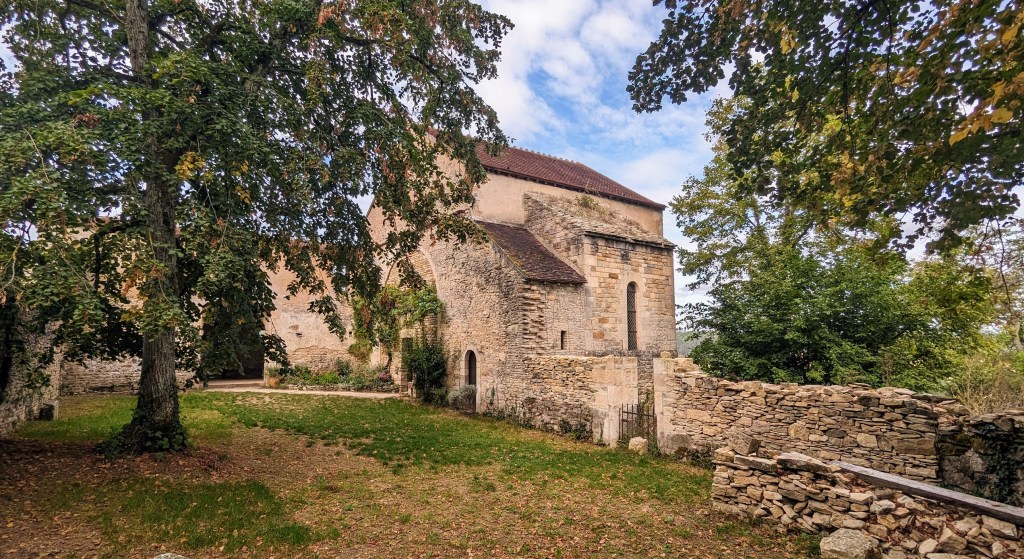
Don’t be fooled: built originally in 1146, this place is still pretty much alive. Several Franciscan monks live there, and many people come here to visit them, to attend worship services, to meditate in silence, and also to volunteer in an extensive restauration and renovation project.
I liked very much the official motto of this monastic community. In English, it is: “Renovate to perpetuate a place of welcome and life as brothers.” In French, this message is conveyed through the many printed materials available at the monastery. It looks like this:

Several worship services are conducted each day and they are all open to public.

I came in the late afternoon, when the church was empty and silent. I loved the simplicity and almost austerity of its interior: no frills so as to not distract from the main goal – prayer and contemplation.

The Catholic monastic orders of Franciscan monks and nuns have hundreds of chapters and locations all around the globe. Yet, La Cordelle has a special place among them. In 1217, first Franciscan monks were sent outside of Italy to spread the vision of St. Francis. The same year, La Cordelle has become the very first Franciscan monastic community on French soil (originally, the Benedictine monks owned the place, but they “hosted” Franciscans and then gave them this property).
From La Cordelle, I returned back to Vezelay taking a longer way around town walls. The fall began to change the color of the leaves and the old farmhouses looked quite picturesque.

It was getting dark quickly, and my host in Vezelay was waiting for me. I was lucky to stay not in a hotel, but in a home of an Orthodox Christian priest, Fr. Stephen Headley.
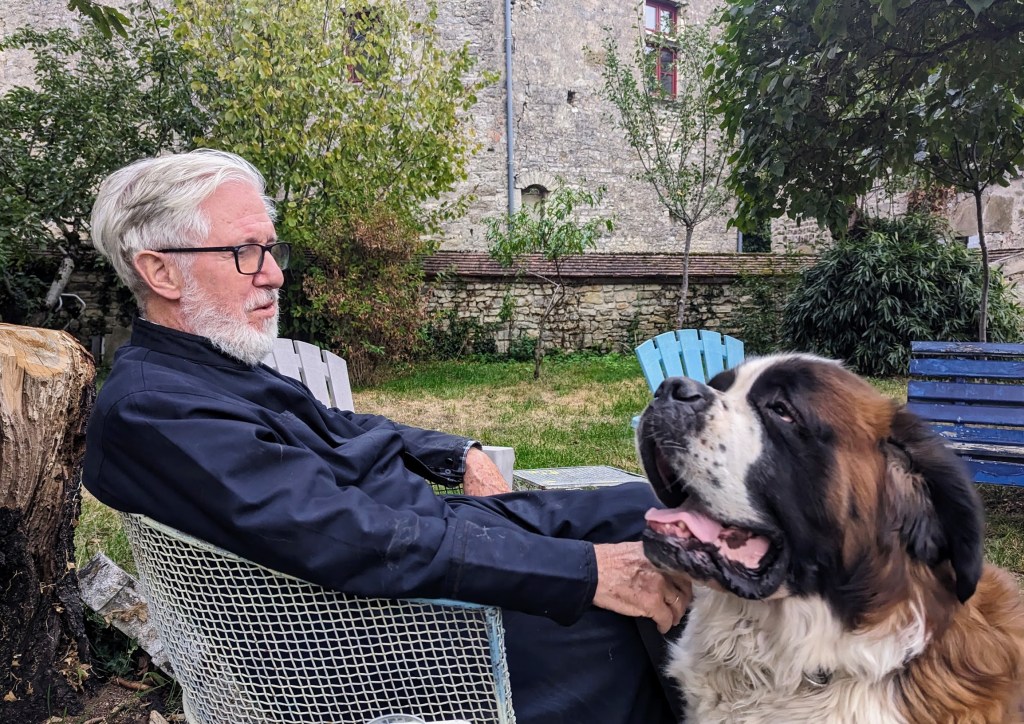
And now is the time to tell the story of the third religious community in Vezelay: the Saint Etienne and Saint Germain Orthodox Christian Church. Unlike Roman Catholics, Orthodox Christians are a small religious minority in France (about 0.7% of population). To have an Orthodox Christian Church in a provincial French town with the deep Catholic historic roots is highly unusual. Yet, the St. Etienne and St. Germain Church occupies a very prestigious spot in Vezelay: right off the main plaza and literally in the “shadow” of looming Vezelay Abbey. Look at the street on the right side of this Cafe de la Terrasse (which is next to Basilica).

Then walk about 50 meters along this street: on your left side you will see a small ancient house with a narrow door and a sign “Eglise Orthodoxe:” Orthodox Church.


The first floor is a combination of a small library and meeting room. The walls are decorated with Orthodox Christian paintings and icons. Combined with brightly lit candles, the overall vibe is both intimate and sacred.

On the second floor is the sanctuary, the worship area. I have been to many Orthodox Churches, but there is something special about atmosphere in this – rather small – place. It felt like traditional elements of Orthodox church interior (icons, paintings, candles, old prayer books, smell of incense) were very fitting into medieval walls and massive vaults of the house. The most original form of Christianity (Orthodox Church) found an equally “historically deeply rooted” home in Vezelay.

The story of St. Etienne and St. Germain Church is inseparable from the story of its priest: Fr. Stephen Headley. An American from Pennsylvania, in the late 1960s, he graduated simultaneously from Columbia University in New York (with degree in Buddhist studies) and from St. Vladimir’s Orthodox seminary (with degree in theology). All his following life was an intertwining of two – both successful – careers: as an accomplished social anthropologist and an Orthodox priest.
In early 1970s, he moved to France. Rising fast through the ranks in academic world, he became a renowned expert on the ethnography of Central Java in Indonesia. Simultaneously he served as a clergyman in an Orthodox parish in Paris. Somehow, Fr. Stephen managed not only “reconcile” these two different careers, but even blended them nicely. Indeed, he is best known for the books on anthropology of prayer.

His wife (“matushka”) Anna was also from the U.S. A talented painter, she created many artworks including both secular paintings and Orthodox icons. One of her icons attracted my attention. It depicted various “Western” Saints originating from Bourgogne in France. These are not typical images which one can see in the Eastern Orthodox churches. And yet, all of them lived before separation between the Catholic and Orthodox Churches. They were all Saints from then still undivided Christian Church.

Fr. Stephen and his wife discovered Vezelay while being on vacations, loved it and decided to move here. It was almost a miracle that they were able to find in the very heart of Vezelay both their private house and – very close to it – an old abandoned building. The local government gave this building to Fr. Stephen so that it can be restored and used as a church.
Predictably, St. Etienne and St. Germain is a small parish: about 60-70 members total with 20-40 gathering to worship every Sunday. But its impact is greater than the numbers may suggest: many old friends and former parishioners from Paris also come here regularly, bringing with them their families and non-Orthodox friends.
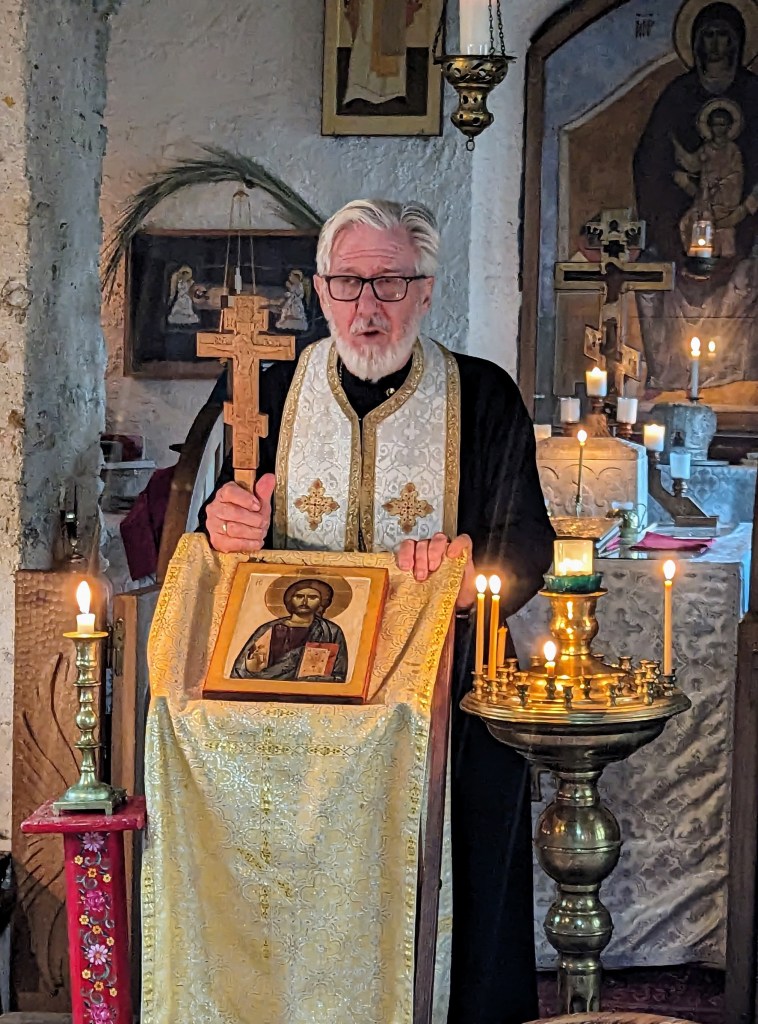
Not many people are coming here on weekdays. But regardless of attendance, Fr. Stephen conducts two services daily: Matins around 9 am and Vespers around 6 pm. The doors are open and everyone is welcome to join any time. My visit was also during the week, and I enjoyed going to St. Etienne and St. Germain, helping in basic preparations (lighting candles, moving stands with prayer books) and then simply joining Fr. Stephen in prayer and recitation.

My bedroom was on the second floor of the house. Its window looked into Fr. Stephen’s spacious garden with Basilica of Vezelay in the background. People who visit Fr. Stephen and his regular parishioners like to spend time sitting together in this garden and sharing “good time and good stories.”
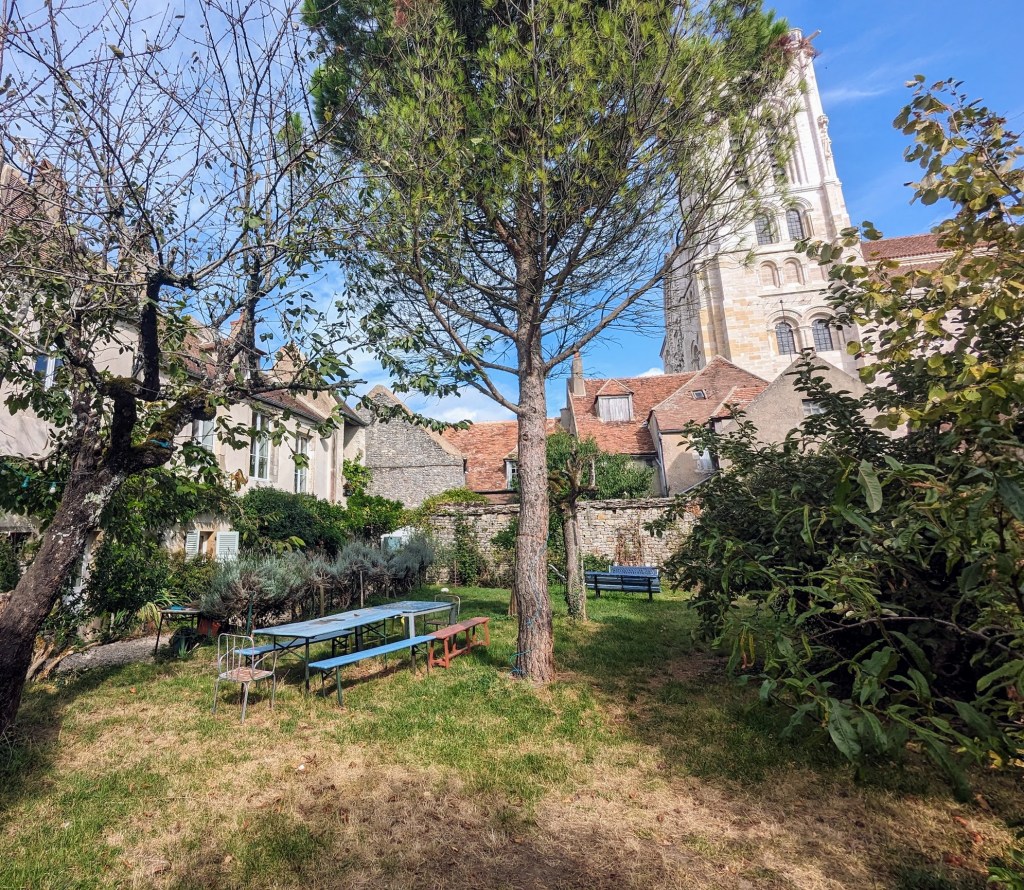
I think, you got the picture: Vezelay offers an abundant “spiritual nourishment.” However, those who are interested in a more “bodily” gourmet experience will not be disappointed as well. A few restaurants on the main street will indulge you in the local cuisine. Besides restaurants, three other food places attracted my attention. One was this ice cream shop with good variety of flavors: all are home-made from the scratch.

The second place is for the lovers of pastries. This tea room offers a variety of home-produced “macarons,” the French meringue-based cookies made with egg white, granulated sugar, almond meal and other ingredients.

Finally and, perhaps, most importantly, if your time in Vezelay is limited, there is one place (also on the main street) with wide variety of local foods and wines. Many of them can also be tested on premises. Here is the name and address of this “one stop shop.”

Inside this store, a welcoming fellow will explain what is this area known for (from the gourmet point of view) and will give you the samples of the local “tastes and flavors.”

I stayed two days in Vezelay and could have easily stay longer. On the morning of departure, we sat with Fr. Stephen in his garden. He told me about many future plans: for himself, his parish, and also the town as a whole. Mentally, I scratched my head and thought: there should be something truly vibrant about Vezelay – the town where even people in a fairly advanced age still make far-reaching plans and look in the future rather than in the past. And I was very grateful to Fr. Stephen for sharing his home and immersing me into the life of Vezelay. I will be back. For sure.
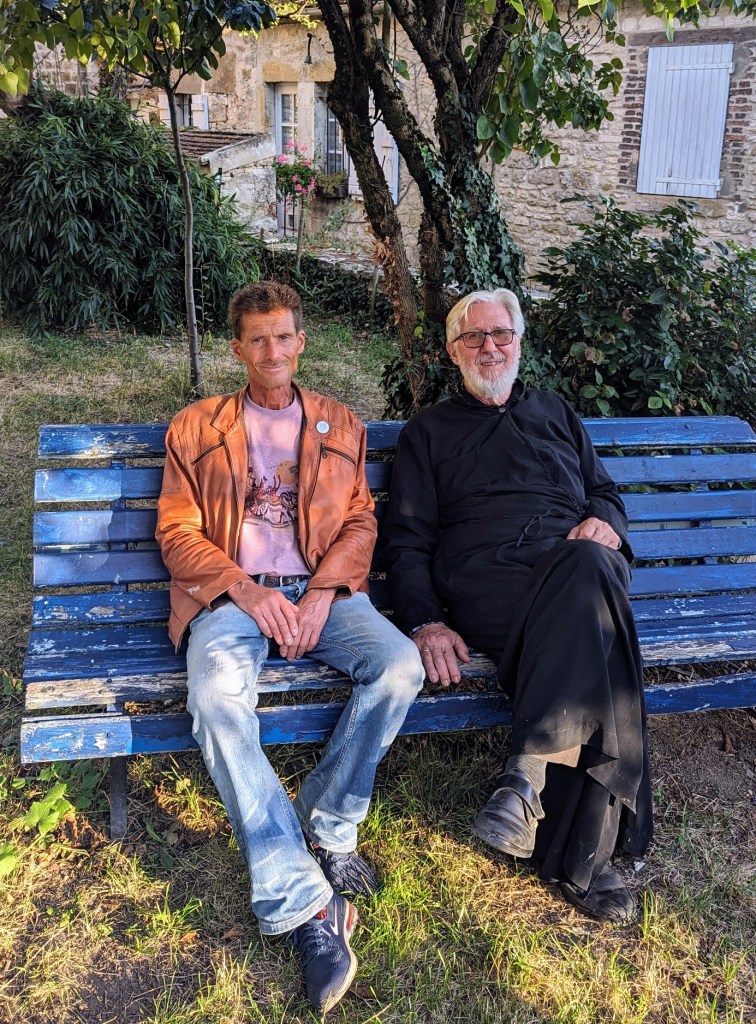





Thank you.
This looks extremely charming. The priest is under which Church?
Bp Luke
Sent from my iPhone
LikeLike
He is part of Moscow Patriarchate.
<
div>Hope everything is well
LikeLike
Thank you
Sent from my iPhone
LikeLike
Thank you so much for you sharing this beautiful history .
LikeLike
This was fantastic, thank you so much ! Blessings, Father Paul
>
LikeLike
Greetings Alexei !
<
div dir=”ltr”>Heidi & I so enjoy your travel writings. You are truly an adventurer extraordinaire! Thank you for sharing with us. We note th
LikeLike
Thank you for this article. Funny thing is that I went on a two month college tour of Europe in 1985 and Vezelay was one of our stops!!!
Didn’t realize there was an Orthodox Church there. I recall there being relic of St Mary Magdaline, hand or finger.
LikeLike